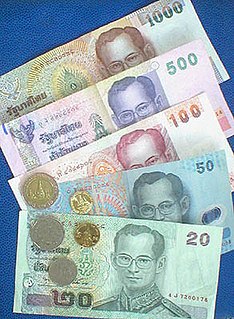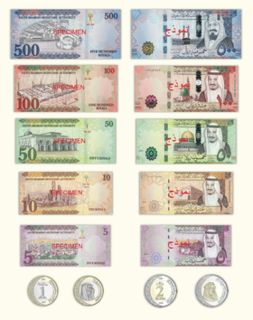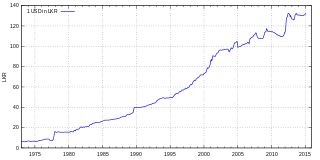
The krona is the official currency of Sweden. Both the ISO code "SEK" and currency sign "kr" are in common use; the former precedes or follows the value, the latter usually follows it but, especially in the past, it sometimes preceded the value. In English, the currency is sometimes referred to as the Swedish crown, as krona literally means "crown" in Swedish. The Swedish krona was the ninth-most traded currency in the world by value in April 2016.

The złoty, which is the masculine form of the Polish adjective 'golden', is the currency of Poland. The modern złoty is subdivided into 100 groszy. The recognised English form of the word is zloty. The currency sign, zł, is composed of the Polish lower-case letters z and ł.

The Australian dollar is the legal tender of Australia, and the currency of three independent Pacific Island states, specifically Kiribati, Nauru, and Tuvalu. It was introduced on 14 February 1966 when the pre-decimal Australian pound, with subunits of shillings and pence, was replaced by the new decimal currency, the Australian dollar.

Baht is the official currency of Thailand. It is subdivided into 100 satang. The issuance of currency is the responsibility of the Bank of Thailand.

The Philippine peso, also referred to by its Filipino name piso, is the official currency of the Philippines. It is subdivided into 100 centavos or sentimos in Filipino. As a former colony of the United States, the country used English on its currency, with the word "peso" appearing on notes and coinage until 1967. Since the adoption of the usage of the Filipino language on banknotes and coins, the term "piso" is now used.

The forint is the currency of Hungary. It was formerly divided into 100 fillér, as today, fillér coins are no longer in circulation. The introduction of the forint on 1 August 1946 was a crucial step in the post-World War II stabilisation of the Hungarian economy, and the currency remained relatively stable until the 1980s. Transition to a market economy in the early 1990s adversely affected the value of the forint; inflation peaked at 35% in 1991. Since 2001, inflation is in single digits, and the forint has been declared fully convertible. As a member of the European Union, the long-term aim of the Hungarian government may be to replace the forint with the euro, but that does not appear to be likely until some time during the 2020s.

The Russian ruble or rouble is the currency of the Russian Federation, the two partially recognised republics of Abkhazia and South Ossetia and the two unrecognised republics of Donetsk and Luhansk. The ruble is subdivided into 100 kopeks.

The krone is the official currency of Denmark, Greenland, and the Faroe Islands, introduced on 1 January 1875. Both the ISO code "DKK" and currency sign "kr." are in common use; the former precedes the value, the latter in some contexts follows it. The currency is sometimes referred to as the Danish crown in English, since krone literally means crown. Historically, krone coins have been minted in Denmark since the 17th century.

The Israeli new shekel, also known as simply the Israeli shekel, is the currency of Israel and is also used as a legal tender in the Palestinian territories of the West Bank and the Gaza Strip. The new shekel is divided into 100 agora. The new shekel has been in use since 1 January 1986, when it replaced the hyperinflated old shekel at a ratio of 1000:1.

The tenge is the currency of Kazakhstan. It is divided into 100 tıyn. The ISO-4217 code is KZT.

The Malaysian ringgit is the currency of Malaysia. It is divided into 100 sen (cents). The ringgit is issued by the Bank Negara Malaysia.

The Saudi riyal ; is the currency of Saudi Arabia. It is abbreviated as ر.س or SAR (Saudi Arabian Riyal). It is subdivided into 100 halalas.

The Indian rupee is the official currency of India. The rupee is subdivided into 100 paise, though as of 2019, coins of denomination of 1 rupee is the lowest value in use. The issuance of the currency is controlled by the Reserve Bank of India. The Reserve Bank manages currency in India and derives its role in currency management on the basis of the Reserve Bank of India Act, 1934.

The rupee is the currency of Sri Lanka, divided into 100 cents. It is issued by the Central Bank of Sri Lanka. The abbreviation is generally Rs., but "LKR" is occasionally used to distinguish it from other currencies also called rupee.

The đồng has been the currency of Vietnam since May 3, 1978. Issued by the State Bank of Vietnam, it is represented by the symbol "₫". Formerly, it was subdivided into 10 hào, which were further subdivided into 10 xu, neither of which are now used. Since 2012 the use of coins has decreased greatly, and since 2014 coins are generally not accepted in retail, but will still be accepted in some, but not all, banks.

The Fijian dollar has been the currency of Fiji since 1969 and was also the currency between 1867 and 1873. It is normally abbreviated with the dollar sign $, or alternatively FJ$ to distinguish it from other dollar-denominated currencies. It is divided into 100 cents.

The shilling is the currency of Kenya. It is divided into 100 cents.

The South Sudanese pound is the official currency of the Republic of South Sudan. It is subdivided into 100 piasters. It was approved by the Southern Sudan Legislative Assembly before secession on 9 July 2011 from Sudan. It was introduced on 18 July 2011, and replaced the Sudanese pound at par.
The Brazilian real is the official currency of Brazil. It is subdivided into 100 centavos. The Central Bank of Brazil is the central bank and the issuing authority. The real replaced the Brazilian cruzeiro.



















